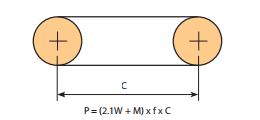Introduction
A cautious evaluation with the circumstances surrounding a conveyor is necessary for precise conveyor chain assortment. This segment discusses the fundamental concerns required for thriving conveyor chain choice. Roller Chains tend to be employed for light to moderate duty material handling applications. Environmental circumstances could demand the use of unique resources, platings coatings, lubricants or the capacity to operate with out more external lubrication.
Fundamental Information and facts Demanded For Chain Choice
? Type of chain conveyor (unit or bulk) such as the strategy of conveyance (attachments, buckets, by means of rods etc).
? Conveyor layout like sprocket spots, inclines (if any) as well as the quantity of chain strands (N) to be utilized.
? Amount of materials (M in lbs/ft or kN/m) and variety of material for being conveyed.
? Estimated weight of conveyor elements (W in lbs/ft or kN/m) including chain, slats or attachments (if any).
? Linear chain pace (S in ft/min or m/min).
? Environment during which the chain will operate which includes temperature, corrosion circumstance, lubrication problem etc.
Stage one: Estimate Chain Tension
Utilize the formula under to estimate the conveyor Pull (Pest) and then the chain stress (Test). Pest = (M + W) x f x SF and
Test = Pest / N
f = Coefficient of Friction
SF = Pace Component
Phase 2: Create a Tentative Chain Selection
Working with the Test worth, produce a tentative selection by picking a chain
whose rated working load better compared to the calculated Check worth.These values are acceptable for conveyor services and are diff erent from these shown in tables on the front from the catalog that are linked to slow velocity drive chain utilization.
In addition to suffi cient load carrying capability frequently these chains needs to be of the specified pitch to accommodate a sought after attachment spacing. One example is if slats are for being bolted to an attachment just about every 1.five inches, the pitch with the chain chosen should divide into one.5?¡À. Therefore 1 could use a forty chain (1/2?¡À pitch) using the attachments every single 3rd, a 60 chain (3/4?¡À pitch) using the attachments each and every 2nd, a 120 chain (1-1/2?¡À pitch) together with the attachments every single pitch or possibly a C2060H chain (1-1/2?¡À pitch) with all the attachments just about every pitch.
Phase 3: Finalize Assortment – Calculate Actual Conveyor Pull
Following producing a tentative variety we have to verify it by calculating
the actual chain tension (T). To perform this we have to fi rst calculate the actual conveyor pull (P). Through the layouts shown about the proper side of  this page opt for the ideal formula and calculate the complete conveyor pull. Note that some conveyors may be a blend of horizontal, inclined and vertical . . . in that situation determine the conveyor Pull at every area and include them collectively.
this page opt for the ideal formula and calculate the complete conveyor pull. Note that some conveyors may be a blend of horizontal, inclined and vertical . . . in that situation determine the conveyor Pull at every area and include them collectively.
Phase 4: Determine Optimum Chain Stress
The utmost Chain Tension (T) equals the Conveyor Pull (P) as calculated in Phase three divided by the amount of strands carrying the load (N), instances the Speed Element (SF) proven in Table 2, the Multi-Strand Component (MSF) proven in Table 3 along with the Temperature Element (TF) shown in Table four.
T = (P / N) x MSF x SF x TF
Step five: Test the ?¡ãRated Operating Load?¡À with the Selected Chain
The ?¡ãRated Doing work Load?¡À from the selected chain need to be greater compared to the Optimum Chain Tension (T) calculated in Stage four above. These values are proper for conveyor service and therefore are diff erent from people proven in tables in the front in the catalog which are associated with slow pace drive chain utilization.
Stage 6: Verify the ?¡ãAllowable Roller Load?¡À from the Selected Chain
For chains that roll within the chain rollers or on major roller attachments it is actually necessary to check out the Allowable Roller Load?¡À.
Note: the Roller load is established by:
Roller Load = Wr / Nr
Wr = The complete weight carried by the rollers
Nr = The amount of rollers supporting the weight.